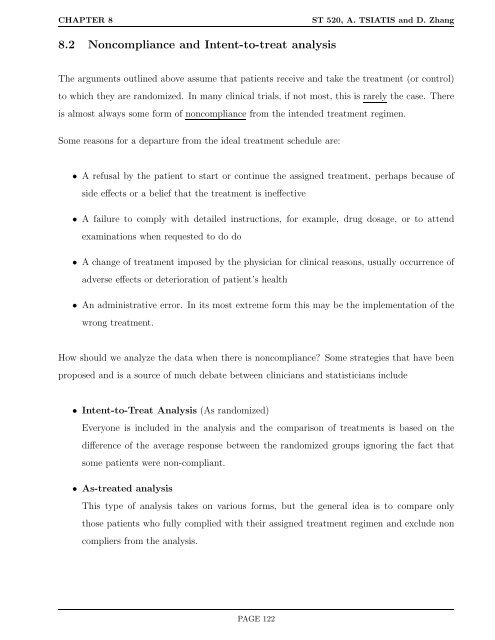ST 520 Statistical Principles of Clinical Trials - NCSU Statistics ...
ST 520 Statistical Principles of Clinical Trials - NCSU Statistics ...
ST 520 Statistical Principles of Clinical Trials - NCSU Statistics ...
You also want an ePaper? Increase the reach of your titles
YUMPU automatically turns print PDFs into web optimized ePapers that Google loves.
CHAPTER 8 <strong>ST</strong> <strong>520</strong>, A. TSIATIS and D. Zhang<br />
8.2 Noncompliance and Intent-to-treat analysis<br />
The arguments outlined above assume that patients receive and take the treatment (or control)<br />
to which they are randomized. In many clinical trials, if not most, this is rarely the case. There<br />
is almost always some form <strong>of</strong> noncompliance from the intended treatment regimen.<br />
Some reasons for a departure from the ideal treatment schedule are:<br />
• A refusal by the patient to start or continue the assigned treatment, perhaps because <strong>of</strong><br />
side effects or a belief that the treatment is ineffective<br />
• A failure to comply with detailed instructions, for example, drug dosage, or to attend<br />
examinations when requested to do do<br />
• A change <strong>of</strong> treatment imposed by the physician for clinical reasons, usually occurrence <strong>of</strong><br />
adverse effects or deterioration <strong>of</strong> patient’s health<br />
• An administrative error. In its most extreme form this may be the implementation <strong>of</strong> the<br />
wrong treatment.<br />
How should we analyze the data when there is noncompliance? Some strategies that have been<br />
proposed and is a source <strong>of</strong> much debate between clinicians and statisticians include<br />
• Intent-to-Treat Analysis (As randomized)<br />
Everyone is included in the analysis and the comparison <strong>of</strong> treatments is based on the<br />
difference <strong>of</strong> the average response between the randomized groups ignoring the fact that<br />
some patients were non-compliant.<br />
• As-treated analysis<br />
This type <strong>of</strong> analysis takes on various forms, but the general idea is to compare only<br />
those patients who fully complied with their assigned treatment regimen and exclude non<br />
compliers from the analysis.<br />
PAGE 122
















